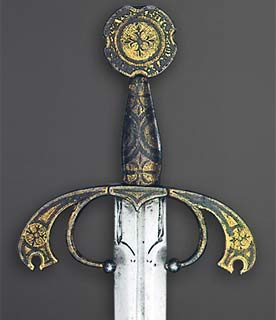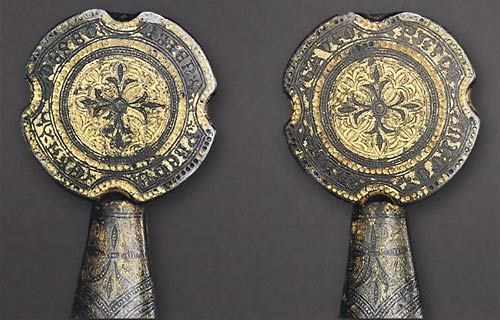| Author |
Message |
Nathan Robinson
myArmoury Admin


|
 Posted: Wed 24 Nov, 2004 3:29 am Post subject: Sword, said to be of Ferdinand II Posted: Wed 24 Nov, 2004 3:29 am Post subject: Sword, said to be of Ferdinand II |
 |
|
Sword, said to be of Ferdinand II

Click for detailed version
Spain, late 15th century
Steel, iron, and gold
Madrid, Real Armeria (Inv. G 31)
Overall length: 37 1/8 in. (95.5 cm)
 
Click for detailed versions
The double-edged blade, engraved with lines following the contours of the thickened shoulder (ricasso) near the hilt, has a longitudinal channel on either side extending to mid-blade, which accommodates the two-part signature ANTONIVS/ME FECIT (Antonio made me) on the obverse and reverse respectively. 1 The hilt is constructed entirely of iron, engraved, punched, gilded, and in part blackened. It is ornamented with beaded and dotted bands outlining the contours and framing medallions that enclose rosettes. The cross-guard (quillons) is flat, curved downward, and flared at the ends, where there is a small ornamental notch; the arms of the hilt end with short ball tips projecting at right angles to the plane of the blade. The grip shows signs of having been shortened. The pommel, a disk quartered by notches, is inscribed on the obverse and reverse respectively: SIEN/PRE GV/ERA/DESEO and PAZ CO/MIGO/NVN/CA VEO (Siempre guerra deseolPaz conmigo nunca veo—“War is ever my desire/Peace with me I never see”). This bellicose legend is not well suited to Ferdinand, who used the famous motto Tanto monta. Nor is there any reason to suppose that it applies to Isabella, his wife, with whom this sword was associated in the middle of the nineteenth century, probably because of its small size. The tradition of Ferdinand's ownership goes back at least to the middle of the sixteenth century, but always with a "said to be," expressing some reserve.
Accredited with this royal connotation, the sword formed part of the armory of Don Carlos (1545-1568), son of Philip II, and appears in inventories of the auction of his effects, appraised at five ducats. By virtue of that tradition, it was placed in the Royal Armory in 1571 by order of Philip II, who was at the monastery of El Escorial at the time:
Una espada bieja con la guarnicion a la antigua dorada y negra y el puno de yerro dorado que diz que fue del Rey catholico con la bayna de terciopelo negro tassada en cinco ducados que entrego en la armeria de su Ma-gestad por su mandado y con interbencion del prior don antonio su cavallerizo mayor como parece por una cedula de su Magestad su fecha en el monesterio de san lorenco el Real a treinta de jullio de mill quinientos y setenta un afios y certificacion del dicho prior del entrego della en la armeria. 2
(An old sword, gold and black hilt of old-fashioned type, gilded iron grip, said to have belonged to the Catholic King, black velvet scabbard, assessed at five ducats, delivered to His Majesty's armory at his command and with the assistance of the prior Don Antonio, his Master of the Horse, as appears by an order of His Majesty dated at the Monastery of San Lorenzo el Real the thirtieth of July fifteen hundred and seventy-one, and certification by the said prior of delivery thereof to the armory.)
The sword is indeed identifiable in the Royal Armory inventory of 1594, where it is mentioned in similar terms:
Otra espada Corta Espanola con canal hasta la mitad con una guarnicion de cruz a la Antigua dorada y el puno de hierro dorado que dizen fue del rrey Catolico. (Inventory of 1594)
(Another short Spanish sword, with a channel half the length, with a gilded cross-hilt of old-fashioned type and gilded iron grip, said to have belonged to the Catholic King.)
The sword is today without a scabbard. Evidently, this was refurbished from time to time; the black velvet covering noted in 1571 had by the end of the eighteenth century become red velvet trimmed with gold braid and fitted with a metal chape.
The Royal Armory formerly had another sword traditionally considered to have belonged to Ferdinand the Catholic, which was presented to the reigning monarch in 1598 by the duchess of Medina-Sidonia. Although the whereabouts of that sword are today unknown, the Royal Armory inventory of 1625 describes it as bearing the names of the three continents of the ancient world, Europe, Africa, and Asia, thus suggesting a date of manufacture prior to the discovery of America in I492. 3
In this context, besides the ceremonial sword GI in the Royal Armory (cat. 12), mention may be made of a sword of Ferdinand's in the cathedral of Granada, as well as an armor and a helmet of his in Vienna (Hofjagd- und Rüstkammer, inv. A 5, A 645).
1. The maker's mark lower down the blade has been attributed to the Biscotto family, Italian bladesmiths of Villa Basilica, near Lucca (Reid 1965), although no member of the family is known to have worked in Spain. Hispano-Flemish sources, on the other hand, point to the existence of a well-known master "Antonius" active in Spain—and by implication Spanish—who signed his blades with his Christian name and a mark identical or similar to this one (clearly depicted in a drawing of sword makers' marks, Senales de las buenas espadas Antiguas, Madrid, Biblioteca Nacional, MS 10806, fol. 102; L'Hermite [1600] 1896).
2. Archive General de Simancas, Contaduria mayor de Cuentas, primera epoca, legajo 1051, fol. 127.
3. "Una Espada corta de A caballo Ancha con una sesma de Recaco dorado con unas letreros que di$en Asia, Africa y Eu-ropa con una guarnicion sogueada de una puente dorada Antigua que dicen es de el Rey Don fernando el chatolico quel presento la duquesa de medina sidonia" (A short sword, for use on horseback, with a section of the gilded ricasso with letters reading Asia, Africa, and Europe, with a hilt with roped decoration having a gilt guard of old-fashioned type, said to be that of the king Don Ferdinand the Catholic, which was presented by the duchess of Medina-Sidonia).
LITERATURE
Abadfa 1793, p. 6 (A.2, no. 23); Jubinal and Sensi [ca. 1839], I, p. 15, pi. 16; Martfnez del Romero 1849, pp. 82-83, no. 1705; L'Hermite [1600] 1896, p. 293; Valencia de Don Juan 1898, pp. 197, 213-214, fig. 127; Gomez-Moreno 1923; Dean 1929, p. 83, no. 76, pi. xxvi; Aguado Bleye 1949; Reid 1965, p. 8; Boccia and Coelho 1975, pp. 339, 348, 355, nos. 124, 184, 248; Thomas and Gamber 1976, pp. 118-120, pis. 52, 53; Norman 1980, p. 80.
Copyright © 1991 The Metropolitan Museum of Art, New York
.:. Visit my Collection Gallery :: View my Reading List :: View my Wish List :: See Pages I Like :: Find me on Facebook .:.
|
|
    |
 |
|
Adam Lloyd
Location: Chicago, IL Joined: 29 Jan 2004
Posts: 91
|
 Posted: Wed 24 Nov, 2004 4:23 pm Post subject: Posted: Wed 24 Nov, 2004 4:23 pm Post subject: |
 |
|
|
Craig Johnson mentions in another post recently that a sword like this is a typical ornate sword from this period. he also mentions some design elements that aren't that popular with modern eyes. This type of sword looks a lot like those cheap toledo, Spain repros that we see a lot of. But now that I see a real antique version i can see how absolutely beautiful this type of sword really is. I never thought i'd like these but this is simply stunning. I think a big diff is that it looks quite functional and deadly unlike the newly made shiny repros that you see like this that only look like jewelry or something. this is really stunning piece
|
|
  |
 |
Gordon Frye

|
|
    |
 |
|
Adam Lloyd
Location: Chicago, IL Joined: 29 Jan 2004
Posts: 91
|
 Posted: Wed 24 Nov, 2004 7:50 pm Post subject: Posted: Wed 24 Nov, 2004 7:50 pm Post subject: |
 |
|
|
beautiful and deadly just like my ex-wife!
|
|
  |
 |
|
|
You cannot post new topics in this forum
You cannot reply to topics in this forum
You cannot edit your posts in this forum
You cannot delete your posts in this forum
You cannot vote in polls in this forum
You cannot attach files in this forum
You can download files in this forum
|
All contents © Copyright 2003-2024 myArmoury.com — All rights reserved
Discussion forums powered by phpBB © The phpBB Group
Switch to the Basic Low-bandwidth Version of the forum
|

